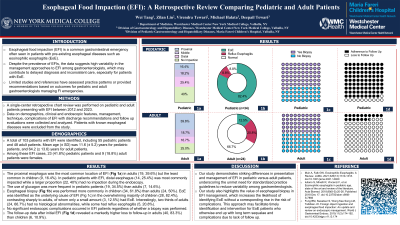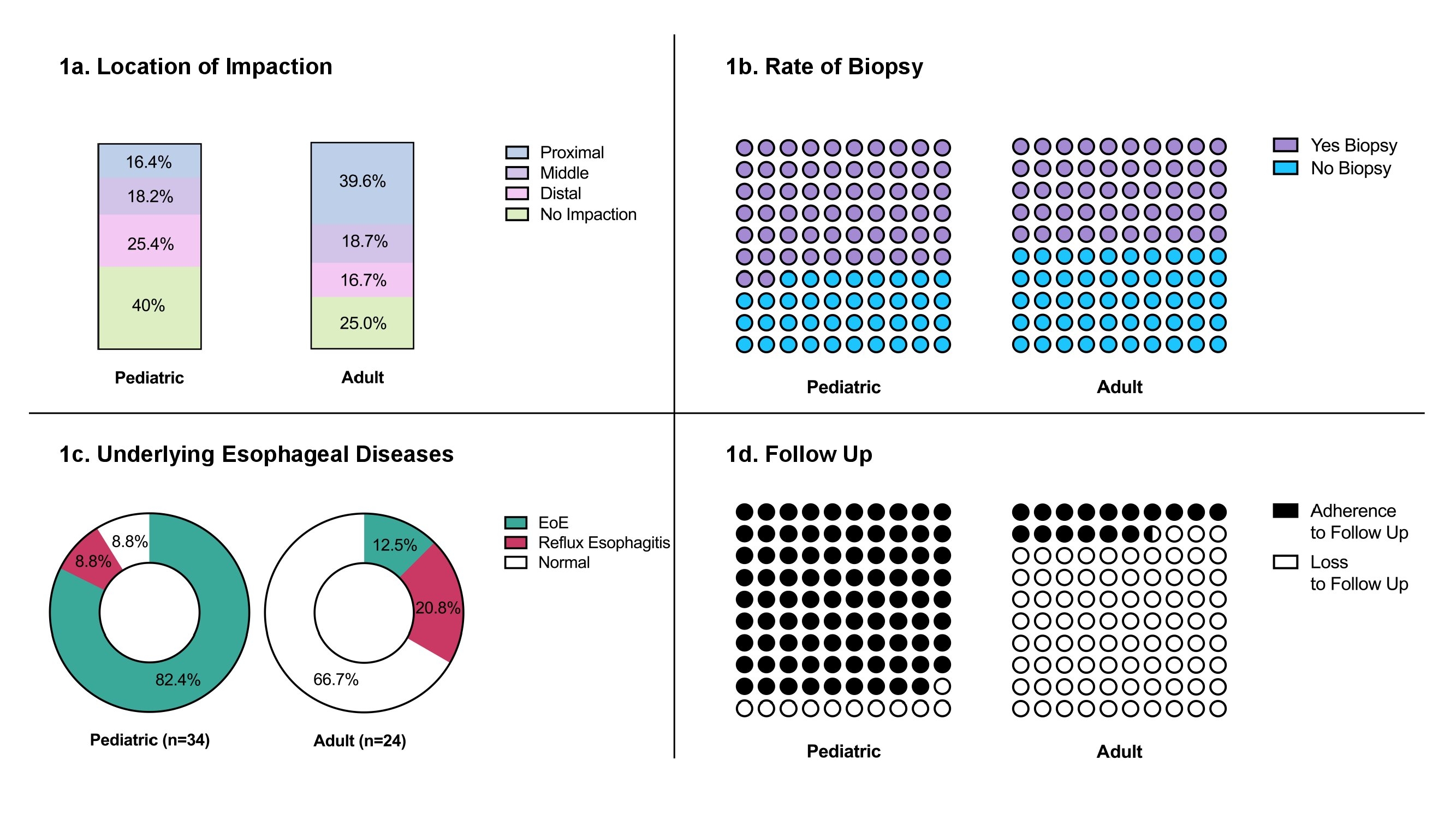Monday Poster Session
Category: Esophagus
P2231 - Esophageal Food Impaction (EFI): A Retrospective Review Comparing Pediatric and Adult Patients
Monday, October 28, 2024
10:30 AM - 4:00 PM ET
Location: Exhibit Hall E

Has Audio

Wei Tang, MD
Westchester Medical Center
Valhalla, NY
Presenting Author(s)
Wei Tang, MD1, Zilan Lin, MD1, Virendra Tewari, MD, FACG1, Michael Halata, MD2, Deepail Tewari, MBBS3
1Westchester Medical Center, Valhalla, NY; 2Boston Children's Hospital, Valhalla, NY; 3Maria Fareri Children's Hospital, Valhalla, NY
Introduction: Esophageal food impaction (EFI) is a common gastrointestinal emergency in all age populations and often occurs in patients with pre-existing esophageal diseases such as eosinophilic esophagitis (EoE).
Even though EFIs are common, the data suggests highly variable practice patterns among gastroenterologists regarding the management of these patients. This variability may lead to delayed diagnosis and inconsistent care for patients, particularly in patients with EoE.
There are limited studies and references available that have assessed practice patterns and made recommendations based on outcomes comparing the practices of pediatric and adult gastroenterologists managing FI emergencies.
Methods: A single-center retrospective chart review was performed on pediatric and adult patients presenting with EFI between 2012 and 2023.
Data on demographics, clinical and endoscopic features, management, technique, complications of FI with discharge recommendations and follow up evaluations were collected and analyzed. Patients with known esophageal diseases were excluded from the study.
Results: A total of 103 EFI cases were identified and were composed of 55 pediatric and 48 adult patients with age (year, mean ± SD) 11.6 ± 5.2 and 64.2 ± 13.6, and female gender 41.7% and 18.2%, respectively.
Proximal esophagus was the most common location of EFI (Fig 1a) in adults (19, 39.6%) but the least common in children (9, 16.4%).
Glucagon was administered more in children (19, 34.5%) than adults (7, 14.6%).
Biopsy (Fig 1b) was more regularly performed in children (34, 61.8%) than adults (24, 50%). EoE was the underlying cause of EFI (Fig 1c) in the overwhelming majority of children (28, 82.4%) in contrast to adults (3, 12.5%). Interestingly, two thirds of adults (24, 66.7%) had no histological abnormalities, while some had reflux esophagitis (5, 20.8%).
No significant endoscopic complication occurred in EFI patients.
Loss to follow-up after initial EFI (Fig 1d) was high in adults (40, 83.3%) but uncommon in children (6, 10.9%).
Discussion: Our study demonstrates striking difference in presentation and management of EFI in pediatric versus adult patients.
Esophageal biopsy, despite being infrequently performed in both groups, has high yield for EoE and may provide opportunity to identify underlying disease in patients who otherwise lose to follow up particularly in adult population.

Disclosures:
Wei Tang, MD1, Zilan Lin, MD1, Virendra Tewari, MD, FACG1, Michael Halata, MD2, Deepail Tewari, MBBS3. P2231 - Esophageal Food Impaction (EFI): A Retrospective Review Comparing Pediatric and Adult Patients, ACG 2024 Annual Scientific Meeting Abstracts. Philadelphia, PA: American College of Gastroenterology.
1Westchester Medical Center, Valhalla, NY; 2Boston Children's Hospital, Valhalla, NY; 3Maria Fareri Children's Hospital, Valhalla, NY
Introduction: Esophageal food impaction (EFI) is a common gastrointestinal emergency in all age populations and often occurs in patients with pre-existing esophageal diseases such as eosinophilic esophagitis (EoE).
Even though EFIs are common, the data suggests highly variable practice patterns among gastroenterologists regarding the management of these patients. This variability may lead to delayed diagnosis and inconsistent care for patients, particularly in patients with EoE.
There are limited studies and references available that have assessed practice patterns and made recommendations based on outcomes comparing the practices of pediatric and adult gastroenterologists managing FI emergencies.
Methods: A single-center retrospective chart review was performed on pediatric and adult patients presenting with EFI between 2012 and 2023.
Data on demographics, clinical and endoscopic features, management, technique, complications of FI with discharge recommendations and follow up evaluations were collected and analyzed. Patients with known esophageal diseases were excluded from the study.
Results: A total of 103 EFI cases were identified and were composed of 55 pediatric and 48 adult patients with age (year, mean ± SD) 11.6 ± 5.2 and 64.2 ± 13.6, and female gender 41.7% and 18.2%, respectively.
Proximal esophagus was the most common location of EFI (Fig 1a) in adults (19, 39.6%) but the least common in children (9, 16.4%).
Glucagon was administered more in children (19, 34.5%) than adults (7, 14.6%).
Biopsy (Fig 1b) was more regularly performed in children (34, 61.8%) than adults (24, 50%). EoE was the underlying cause of EFI (Fig 1c) in the overwhelming majority of children (28, 82.4%) in contrast to adults (3, 12.5%). Interestingly, two thirds of adults (24, 66.7%) had no histological abnormalities, while some had reflux esophagitis (5, 20.8%).
No significant endoscopic complication occurred in EFI patients.
Loss to follow-up after initial EFI (Fig 1d) was high in adults (40, 83.3%) but uncommon in children (6, 10.9%).
Discussion: Our study demonstrates striking difference in presentation and management of EFI in pediatric versus adult patients.
Esophageal biopsy, despite being infrequently performed in both groups, has high yield for EoE and may provide opportunity to identify underlying disease in patients who otherwise lose to follow up particularly in adult population.

Figure: Figure 1. Comparison of Clinical Variables and Management of Esophageal Food Impaction in Pediatric Versus Adult Patients
Disclosures:
Wei Tang indicated no relevant financial relationships.
Zilan Lin indicated no relevant financial relationships.
Virendra Tewari indicated no relevant financial relationships.
Michael Halata indicated no relevant financial relationships.
Deepail Tewari indicated no relevant financial relationships.
Wei Tang, MD1, Zilan Lin, MD1, Virendra Tewari, MD, FACG1, Michael Halata, MD2, Deepail Tewari, MBBS3. P2231 - Esophageal Food Impaction (EFI): A Retrospective Review Comparing Pediatric and Adult Patients, ACG 2024 Annual Scientific Meeting Abstracts. Philadelphia, PA: American College of Gastroenterology.

